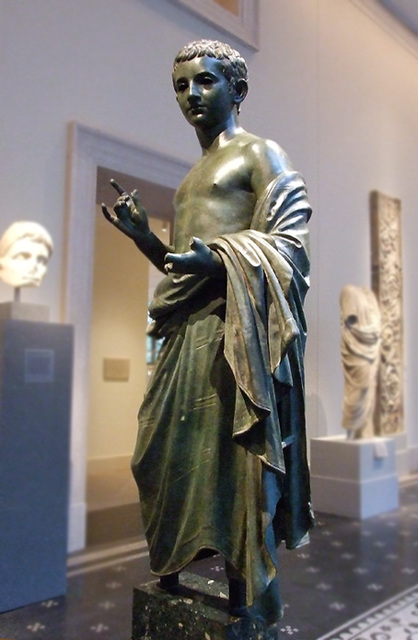Detail of a Bronze Statue of an Aristocratic Boy i…
The Triumph of Love Over Time Mantle Clock in the…
The Visitation in the Metropolitan Museum of Art,…
Plaster Model of Cupid & Psyche by Canova in the M…
Plaster Model of Cupid & Psyche by Canova in the M…
Detail of the Plaster Model of Cupid & Psyche by C…
Paris by Canova in the Metropolitan Museum of Art,…
Paris by Canova in the Metropolitan Museum of Art,…
Bronze Statuette of a Lar in the Metropolitan Muse…
Bronze Statuette of a Lar in the Metropolitan Muse…
Standing Male Worshiper in the Metropolitan Museum…
Head of a Ruler in the Metropolitan Museum of Art,…
Reconstruction Drawing of a Statue of Trebonianus…
Monumental Bronze Statue of the Emperor Trebonianu…
Monumental Bronze Statue of the Emperor Trebonianu…
Monumental Bronze Statue of the Emperor Trebonianu…
Monumental Bronze Statue of the Emperor Trebonianu…
Detail of the Monumental Bronze Statue of the Empe…
Detail of the Monumental Bronze Statue of the Empe…
Detail of the Monumental Bronze Statue of the Empe…
Detail of the Head of the Monumental Bronze Statue…
Detail of the Midsection of the Monumental Bronze…
Detail of a Foot of the Monumental Bronze Statue o…
Bronze Statue of an Aristocratic Boy in the Metrop…
Bronze Statue of an Aristocratic Boy in the Metrop…
Silver Handle from a Serving Dish in the Metropoli…
Detail of a Marble Statue of a Wounded Warrior in…
Detail of the Head of a Marble Statue of a Wounded…
Detail of a Marble Statue of a Wounded Warrior in…
Marble Statue of a Wounded Warrior in the Metropol…
Detail from a Geometric Terracotta Krater in the M…
Detail from a Geometric Terracotta Krater in the M…
Geometric Terracotta Krater in the Metropolitan Mu…
Geometric Terracotta Krater in the Metropolitan Mu…
Detail of a Marble Statue of a Girl in the Metropo…
Marble Statue of a Girl in the Metropolitan Museum…
Marble Statue of a Girl in the Metropolitan Museum…
Detail of a Marble Statue of a Youthful Herakles i…
Detail of the Head of a Marble Statue of a Youthfu…
Marble Statue of a Youthful Herakles in the Metrop…
Marble Statue of a Youthful Herakles in the Metrop…
Marble Statue of a Youthful Herakles in the Metrop…
Marble Statue of a Youthful Herakles with a Little…
Asiatic Garland Sarcophagus with Lid in the Metrop…
Asiatic Garland Sarcophagus with Lid in the Metrop…
Location
See also...
Keywords
Authorizations, license
-
Visible by: Everyone -
All rights reserved
-
1 710 visits
Bronze Statue of an Aristocratic Boy in the Metropolitan Museum of Art, July 2007


Portrait statue of a boy, Late 1st century B.C.–early 1st century A.D.; Julio-Claudian
Roman
Bronze; H. 48 1/2 in. (123.2 cm)
Rogers Fund, 1914 (14.130.1)
The privilege of establishing a public portrait in Republican Rome was based primarily on social status acquired through political and military achievement. Hence, there were few, if any, representations of children. It was not until the advent of Augustus' new Golden Age that significant, imperial portraits of children began to be produced to underscore the dynastic aspirations, as well as the fecundity, of the Julio-Claudian family.
This lifesize bronze statue of a boy wearing a Greek himation (cloak) may well represent Gaius, the adopted grandson of Emperor Augustus. The statue was found on the eastern Mediterranean island of Rhodes, whose ancient Greek cities were wealthy, flourishing centers of commerce and culture during the Roman period.
The Romans considered works in bronze to be more prestigious than those made of marble, and bronze statues were common in the Roman period. However, lifesize bronzes are a rarity in modern collections because they were routinely melted down in the Middle Ages for their inherent metallic value. This notable example is part of a relatively small corpus of large-scale bronze portraits (05.30; 05.47)to have survived, and its quality attests to the superior artistic standards which ancient artists achieved.
Text from: www.metmuseum.org/toah/ho/05/eusb/hod_14.130.1.htm
Roman
Bronze; H. 48 1/2 in. (123.2 cm)
Rogers Fund, 1914 (14.130.1)
The privilege of establishing a public portrait in Republican Rome was based primarily on social status acquired through political and military achievement. Hence, there were few, if any, representations of children. It was not until the advent of Augustus' new Golden Age that significant, imperial portraits of children began to be produced to underscore the dynastic aspirations, as well as the fecundity, of the Julio-Claudian family.
This lifesize bronze statue of a boy wearing a Greek himation (cloak) may well represent Gaius, the adopted grandson of Emperor Augustus. The statue was found on the eastern Mediterranean island of Rhodes, whose ancient Greek cities were wealthy, flourishing centers of commerce and culture during the Roman period.
The Romans considered works in bronze to be more prestigious than those made of marble, and bronze statues were common in the Roman period. However, lifesize bronzes are a rarity in modern collections because they were routinely melted down in the Middle Ages for their inherent metallic value. This notable example is part of a relatively small corpus of large-scale bronze portraits (05.30; 05.47)to have survived, and its quality attests to the superior artistic standards which ancient artists achieved.
Text from: www.metmuseum.org/toah/ho/05/eusb/hod_14.130.1.htm
- Keyboard shortcuts:
Jump to top
RSS feed- Latest comments - Subscribe to the comment feeds of this photo
- ipernity © 2007-2024
- Help & Contact
|
Club news
|
About ipernity
|
History |
ipernity Club & Prices |
Guide of good conduct
Donate | Group guidelines | Privacy policy | Terms of use | Statutes | In memoria -
Facebook
Twitter

Sign-in to write a comment.